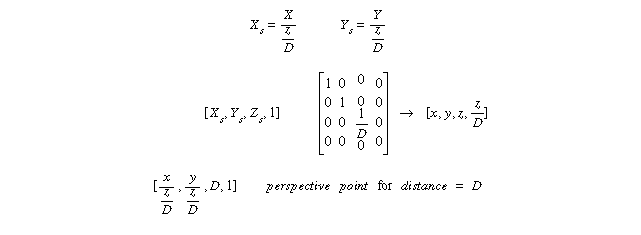 4.4. Homogeneous Co-ordinate System.
4.4. Homogeneous Co-ordinate System.  4.4. Homogeneous Co-ordinate System.
4.4. Homogeneous Co-ordinate System. This system represents a point (x,y,z) in 3-D using 4-D co- ordinates:
i.e. [Wx, Wy, Wz, W ]
[4,6,10,2] == [6,9,15,3] == [2,3,5,1]
Therefore many points in H.C.Space are (x,y,z)

H.C.S can be useful in Transformations:


Other 3-D projections exist:


ignore the z commponent L = length of viewed unit cube
= angle of projection


Develop algorithms for manipulation of object with eye at origin, etc AND
also routines for transforming an object from some arbitrary 3-D coords
into the origin framework.


Where is object? Xobj, Yobj, Zobj
Where is the screen? Defined by View reference point Vrpx, Vrpy, Vrpz
Where is plane normal? ie what orientation is the screen?
View plane Normal: Vpnx, Vpny, Vpnz
What is size of view plane?
Window size ?
Where is eye? Copx, Copy, Copz
What is orientation of eye? Vupx, Vupy, Vupz

The transformation of an object requires:

translation of object s.t. COP is at origin ]
rotation so that VPN is down -ve z axis ] now as before with S & D
rotation so that VUP is up +ve y axis ]
change from World to viewing : exchange z axis
Shear so centred
Scale to fit view volume
Transformpers = Tper. Ry . Rx . Rz . Trl . Sh. Sper
plus clipping.













